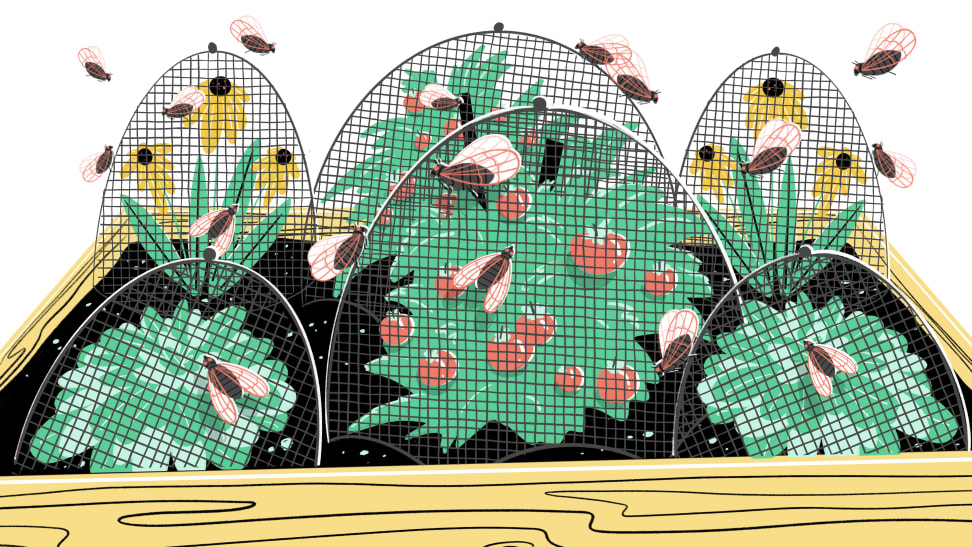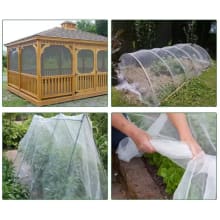4 easy ways to protect your garden from cicadas 2024
Skip insecticides, a net will do.
 Credit:
Reviewed / Tara Jacoby
Credit:
Reviewed / Tara Jacoby
Products are chosen independently by our editors. Purchases made through our links may earn us a commission.
The cicada 2024 season, an ominous-sounding "double brood" of periodical cicadas will emerge simultaneously from their 13- and 17-year snoozes by the billions. For a slim portion of the Midwest, these double broods might even overlap.
Should you be worried? No. Scientists and gardeners agree that cicadas are primarily harmless, with no poison or defense mechanism.
However, cicadas do feed on the sap of woody plants and lay their eggs in trees and other shrubbery. That said, unlike invasive spotted lanternflies, cicadas are native to the U.S. and mainly don't cause much harm to plants. You can even think of them as free mulch for your green spaces and a free lunch for the birds!
Still, if you're an active gardener, keep them off certain plants. There's an excellent way to do that without resorting to harmful pesticides. Here's what you need to know.
What are cicadas?
Cicadas are insects that look like large flies with big heads. There are more than 3,000 species of cicadas, but the bugs that make the headlines are periodical cicadas, who take an all-or-nothing approach to life.
Instead of developing some sneaky way to avoid predators, cicadas’s life strategy is to overwhelm their environment with so many cicadas at a time that some must be able to reproduce.
Most familiar insects hatch, eat, mate, and die in a single season. Periodical cicadas hatch, suck sap from grasses for nourishment, then dig their way underground to subsist on food from plant roots.
Then, years later, cicadas stir when the soil temperature reaches 65°F. All at once, the slumbering bugs dig their way out of the soil, molt—leaving familiar brown cicada skins on trees—and emerge with new wings and a powerful urge to mate.
They swarm on trees, piercing bark to suck sap from branches and twigs while buzzing simultaneously in one of the insect world's loudest natural symphonies. Four to six weeks later, when the cicadas have secured mates, the noise dies down, and the adults lay their eggs and die off.
Are cicadas dangerous to bushes and young trees?
Periodical cicadas are fussy about their food. They pose no threat to humans or animals, and the adults only drink sap from plants with woody stems and branches—the same places they lay their eggs.
Cicadas can attack young woody plants of more than 270 different varieties. Sapling trees, ornamental shrubs, blueberries, grape vines, and bramble fruits like raspberries and blackberries can be targeted. Other plants like oaks, maples, cherries, dogwoods, and redbuds can also be affected.
Newly planted trees and woody plants with stems up to one-half-inch in diameter are vulnerable to damage from cicadas, which suck out sap and cut slits in tree branches to lay clutches of eggs.
Making those slits, known as flagging, won’t hurt mature trees, which can regrow damaged twigs. Unfortunately, young saplings up to four years old may be damaged as females deposit up to 600 eggs in clutches of 25 at a time.
Will cicadas damage gardens and lawns?
Although cicadas swarming over your tomato vines and marigolds may be annoying, they won’t harm your garden flowers or vegetables.
Cicadas also leave lawns alone. You may find cicada emergence holes about a half-inch wide in your lawn, with mud “chimneys” up to 3 inches high. Those holes won’t permanently damage your lawn and may provide helpful aeration.
The upside to cicadas? All those rotting adult bugs act as nitrogen-rich fertilizers. Scientists have found that while oaks grow less than usual during the year that cicadas emerge (and suck the sap out of trees), they grow more than average. The four years after a swarm.
How to protect plants from cicadas
1. Delay any new planting
Prevention is the most effective approach to keeping young trees safe from cicadas. If you live in an area with periodical cicadas, consider delaying planting trees until after the periodical brood emerges.
2. Put up physical barriers
If you already have young trees and bushes in the ground, your best bet is to put up a physical barrier between the cicadas and your plants. Cicadas prefer to lay their eggs in slits in branches with about a half-inch diameter, so your job is to protect those branches.
Wrap your trees, bushes, and shrubs in netting with \one-centimeter or smaller holes to keep cicadas off your plants. You can use fine mesh insect netting or barrier plant bags for individual trees or shrubs. Avoid “bird netting,” which usually has net openings too large to keep cicadas out.
Ensure you tie the bottom of the bag or netting tightly against the bottom of the trunk so that cicadas can’t crawl under the netting. Take the netting down when cicada season is down to allow better air circulation.

Keep the bugs off your fruit trees with this garden netting.

This nylon mesh net is a perfect pick for smaller bushes.
3. Skip chemicals
Avoid chemical insecticides for cicadas.
For one thing, chemical insecticides aren’t as effective as netting. In one study, trees that were treated with typical insecticides suffered eight to 25 times as much damage as trees covered with mesh netting.
For insecticide to be effective, it would need to be applied every two to three days for the entire four to six weeks that adult cicadas are around, as new cicadas will come to your trees from nearby areas. That amount of insecticide will kill bees and other beneficial garden insects. It could poison children, pets, and the birds that eat dead or dying cicadas.
Since cicadas cause minor damage, insecticide is not a good solution.
4. Take extra care to water and mulch
If your trees and woody plants do suffer cicada damage, you can help revive them. Make sure your plants get the equivalent of one inch of water a week, and consider applying mulch around the tree or plant—without touching the trunk—to help water in the soil and help keep the soil temperature moderate.
And take heart! All those cicadas mean food for next year's plants and this year's birds.



